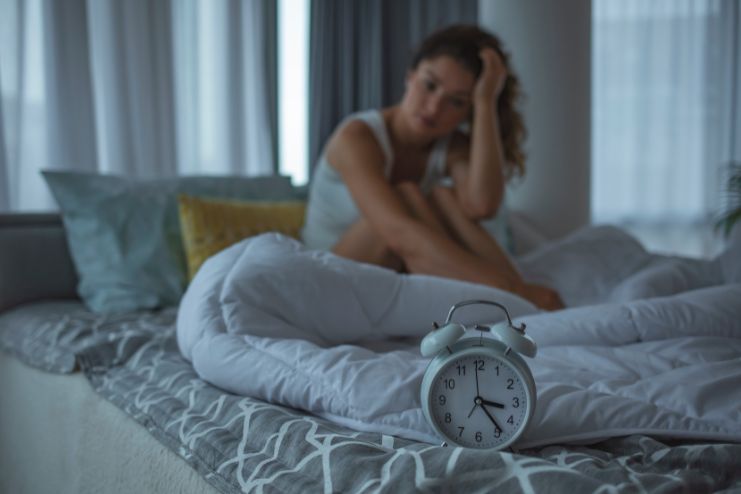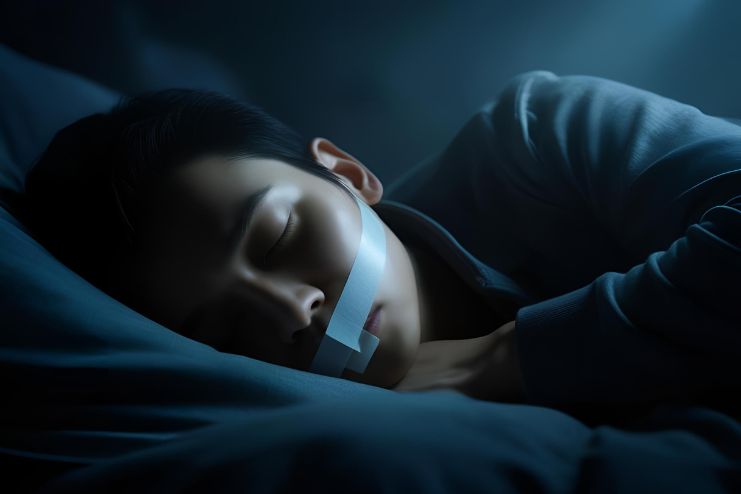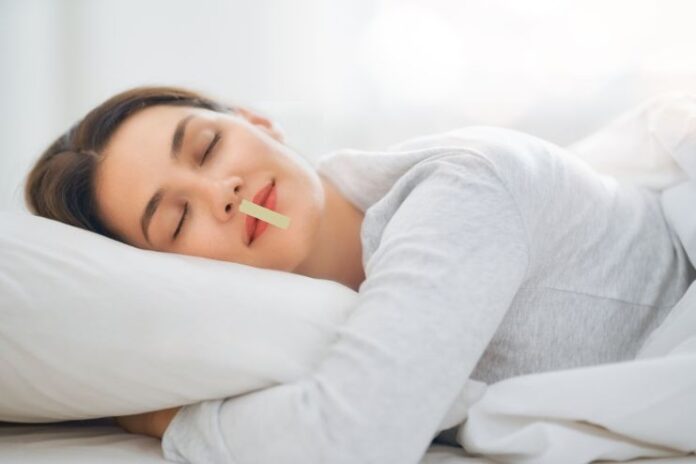Affiliate Disclaimer
Some links in this article are affiliate links. We may earn a small commission if you make a purchase through these links, at no extra cost to you. We only recommend products we find useful to our readersIf you’ve ever woken up with a dry mouth, felt groggy despite getting enough sleep, or had your partner complain about your snoring, you’re not alone. These issues are quite common, and a new sleep trend called mouth taping is gaining popularity as a potential solution.
The idea behind this trend is simple: taping your mouth shut while you sleep encourages nasal breathing instead of mouth breathing. This can have several surprising health benefits, such as reducing snoring, preventing dry mouth, improving oxygen intake, leading to more restful sleep, and boosting daytime energy levels.
But what’s the science behind it? Can a small piece of tape make such a significant difference in your sleep quality and overall health?
Let’s dive deeper into how this technique might work for you!
The Science Behind Mouth Taping
The concept behind mouth taping stems from the difference between nasal and mouth breathing.
Our bodies are naturally designed for nasal breathing, which filters, humidifies, and warms the air before it reaches our lungs. However, many people unknowingly breathe through their mouths while sleeping, leading to issues like snoring, dry mouth, and even sleep apnea.
When you breathe through your mouth, the airway is more likely to collapse, contributing to snoring and interrupted sleep. In contrast, nasal breathing supports better oxygen intake and nitric oxide production, both of which improve overall health and sleep quality.
Researchers have found only limited and inconclusive evidence to support the benefits of mouth-taping during sleep.
Read More: Mouth Taping for Sleep: Does It Really Improve Breathing and Sleep Quality?
Key Benefits of Mouth Taping

Mouth taping has gained popularity as a potential solution for those struggling with snoring, sleep disturbances, and oral health issues. By encouraging nasal breathing, this practice aims to optimize sleep quality and support overall health.
Let’s take a closer look at the key benefits of mouth taping.
- Reduces Snoring: One of the primary benefits of mouth taping is its ability to minimize snoring. Keeping your mouth closed during sleep forces you to breathe through your nose. Since mouth breathing is often a major cause of snoring, this small adjustment can make a big difference in reducing nighttime noise.
- May Improve Sleep Apnea Symptoms: Mouth taping isn’t a cure for sleep apnea, but it may help those with mild cases by encouraging nasal breathing, which keeps the airway open more effectively. For individuals dealing with mild obstructive sleep apnea, mouth taping can be a simple, non-invasive way to manage symptoms.
- Enhances Sleep Quality: Nasal breathing plays a crucial role in regulating oxygen levels, allowing the body to enter deeper, more restorative sleep cycles. Mouth taping promotes better airflow and oxygenation, which improves sleep quality.
- Prevents Dry Mouth and Morning Bad Breath: Mouth breathing can dry out the mouth, reducing saliva production and allowing bacteria to thrive, often causing morning bad breath. By keeping the mouth closed, mouth taping helps retain moisture and promotes fresher breath overnight.
- Supports Oral Health: Chronic dry mouth can lead to a variety of oral health problems, including cavities and gum disease. Mouth taping encourages nasal breathing, which keeps the mouth hydrated and supports healthier teeth and gums. It also creates a more favorable environment for maintaining good oral hygiene.
While more research is needed to fully understand the effects of mouth taping, many people find it to be a helpful tool for improving their overall well-being.
Potential Risks of Mouth Taping

While mouth taping may seem like a simple technique to promote nasal breathing during sleep, it’s important to understand the potential risks associated with mouth taping. What works for one person may not be suitable for another, and in some cases, it can even worsen certain health conditions.
Here are some risks you should consider before trying mouth taping:
- Impaired Breathing: Forcing nasal breathing may be difficult for some people and could result in breathing issues.
- Reduced Oxygen Levels: Mouth taping can reduce oxygen levels in individuals with respiratory issues.
- Disrupted Sleep: The discomfort or anxiety caused by mouth taping can disturb sleep patterns.
- Skin Irritation or Allergic Reactions: The tape itself can lead to skin irritation or an allergic reaction, especially if it’s too strong or unsuitable for sensitive skin.
- Worsening of Underlying Conditions: Mouth taping can make conditions like sleep apnea or nasal blockages worse.
How to Use a Mouth Tape Safely
Mouth taping can be a game-changer for sleep quality, but it’s important to approach it with care. Here’s a guide on how to use mouth tape correctly and comfortably.
- Choose the Right Tape: Opt for a hypoallergenic, skin-safe tape specifically designed for medical use. Avoid using duct tape or anything too harsh on your skin.
- Start Small: If the idea of fully taping your mouth feels overwhelming, try a vertical strip that leaves the corners of your mouth uncovered. This way, you can get used to the sensation gradually.
- Apply Gently: Lightly press the tape over your lips before bed. It should be snug enough to stay in place but not so tight that it feels restrictive.
- Listen to Your Body: If you feel discomfort, anxiety, or find it difficult to breathe, remove the tape immediately. If needed, consult a healthcare professional for advice before trying again.
By following these steps, you can make mouth-taping a safe and comfortable part of your nightly routine!
Read More: 12 Scientifically Proven Tips on How to Have Better Sleep at Night
Who Should & Shouldn’t Try Mouth Taping

While mouth taping is gaining popularity as a potential solution for better sleep, it’s essential to know who might benefit from it and who should avoid it.
Who Can Benefit Most from Mouth Taping?
- For chronic snorers seeking to reduce nighttime noise.
- Individuals with mild sleep apnea (always consult a doctor first).
- People who wake up with a dry mouth or bad breath.
Who Should Avoid It?
While mouth taping has gained popularity for promoting nasal breathing during sleep, it’s not suitable for everyone. Here are the groups that should steer clear of this practice:
- People with Breathing or Sleep Disorders: If you struggle with nasal breathing, have been diagnosed with or suspected of sleep apnea, or any form of respiratory distress, mouth taping can be dangerous and may worsen your condition.
- Those with Nasal Obstructions: Conditions like a deviated septum, nasal polyps, chronic allergies, or congestion can make nasal breathing difficult, making mouth taping unsafe.
- Individuals with Certain Medical Conditions: People with severe heart or lung issues, obesity, or respiratory infections should avoid mouth taping unless specifically cleared by a healthcare provider.
- Sensitive Skin Types: If you have chapped lips, irritated facial skin, or a known allergy to adhesives, taping your mouth could cause irritation or discomfort.
- Children: Mouth taping hasn’t been studied extensively in children and is not considered safe or even recommended.
- Those Under the Influence: If you’ve consumed alcohol or taken sedatives, avoid mouth taping, as it can increase the risk of breathing complications while sleeping.
- Individuals with Anxiety or Claustrophobia: The sensation of having your mouth taped shut may trigger panic or discomfort in those prone to anxiety.
Always consult a healthcare professional before attempting mouth taping. It may mask underlying health issues and is not a substitute for proper diagnosis and treatment.
Debunking Common Myths About Mouth Taping
As with any popular wellness trend, mouth taping has generated plenty of buzz, but not all of the information circulating is accurate.
Let’s take a closer look at some of the most common myths surrounding mouth-taping and separate fact from fiction:
- Mouth taping is dangerous and can stop you from breathing.
Fact: If you can breathe comfortably through your nose, mouth-taping is generally safe. However, if you have nasal congestion or difficulty breathing through your nose, it’s best to avoid this practice.
- You need to use strong tape for it to work.
Fact: A gentle, hypoallergenic tape is sufficient to keep your mouth closed. There’s no need for a strong adhesive that might cause discomfort or irritation.
- Mouth taping cures sleep apnea.
Fact: Mouth taping can reduce symptoms in mild cases, but it does not cure sleep apnea.
- Everyone can benefit from mouth taping.
Fact: Mouth taping is not for everyone. Individuals with nasal blockages, severe sleep apnea, or anxiety about taping should avoid it and consult a healthcare provider.
- Mouth taping instantly stops snoring.
Fact: While it may help reduce snoring for some people, it’s not a guaranteed solution. The effectiveness can vary depending on the cause of snoring.
- Mouth taping improves oral health.
Fact: While keeping your mouth closed during sleep may prevent dry mouth and reduce bad breath, there’s no conclusive evidence that mouth taping improves overall oral health.
- Mouth taping is a proven scientific practice.
Fact: Although there are anecdotal reports of its benefits, the scientific evidence supporting mouth taping is limited and inconclusive. Always consult a healthcare professional before trying new health practices.
Final Thoughts
In conclusion, mouth taping is an emerging wellness practice aimed at promoting nasal breathing during sleep, potentially improving sleep quality, and reducing snoring. Approach mouth taping with caution and avoid it unless a healthcare professional advises you to proceed.
The key is understanding your body, choosing the right tape, and being mindful of any discomfort or breathing difficulties. Myths surrounding mouth taping can be misleading, so it’s important to separate fact from fiction.
Mouth taping can be helpful, but it’s not a guaranteed solution for everyone. Start slow and see how your body responds.
Remember, health is personal—what works for one may not work for all.
In this Article






















